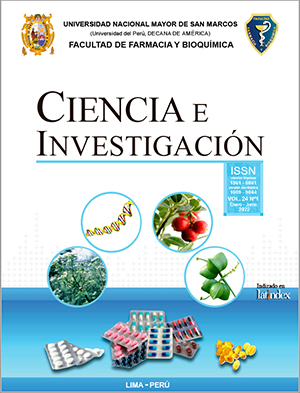Prevalence of fluconazole and voriconazole resistance genes from Candida albicans strains isolated from patients at the Luis Nicasio Sáenz Police Hospital Complex - 2018
DOI:
https://doi.org/10.15381/ci.v24i1.22237Keywords:
Candida albicans, prevalence, fluconazole, voriconazole, ERG11 gene, Y257H, resistance genes, patients, hospitalAbstract
Infections caused by C. albicans are of three types: cutaneous, mucosal, and systemic. In our investigation, it was a systemic infection in patients with fungemia who were isolated strains of C. albicans from blood cultures. The purpose of this research was to determine the prevalence of genes for resistance to fluconazole and voriconazole in strains of Candida albicans isolated from blood cultures in patients from the Luis Nicasio Sáenz-2018 Police Hospital Complex. 176 strains of Candida spp. that were isolated from blood cultures and for the identification of C. albicans, the germ tube test was performed and confirmed with the MicroScan RAPID YEAST ID PANEL identification test. For the susceptibility test, it was performed by the disk diffusion method. Then a PCR analysis is carried out and then sequencing with the ABI 3730xl (Applied Biosystems, Foster City, California, USA) of the ERG11 gene and analyzed by BLAST and MEGA 6.0 obtaining 39 (22 %) were C. albicans. The resistance of fluconazole and voriconazole was determined was 3 (7.7 %) and 2 (5.1 %) respectively for C. albicans. The isolated strains of C. albicans with resistance to azoles (fluconazole and voriconazole) were three strains resistant to more than one antifungal. The three strains (strain_Ca1, strain_Ca2 and strain_Ca3), the presence of the ERG11 gene in said strains was determined. For the genotypic characterization of the ERG11 gene, sequencing was performed and then they were compared with the sequence published in GenBank of C. albicans of the ERG11 gene whose genomic sequence AY856352 of 1587 bp. Therefore, the three isolates (strain_Ca1, strain_Ca2 and strain_Ca3) isolated found more than one mutation. The mutation in the T769C is related to the change of amino acids Y257H that were found in the three strains. It is concluded that Y257H is related to a reduced susceptibility to azoles.
Downloads
Published
Issue
Section
License
Copyright (c) 2021 Alberto Javier Ponce-Medina, Luis Alberto Inostroza-Ruiz

This work is licensed under a Creative Commons Attribution 4.0 International License.
LOS AUTORES RETIENEN SUS DERECHOS:
- Los autores retienen sus derechos de marca y patente, y tambien sobre cualquier proceso o procedimiento descrito en el artículo.
- Los autores retienen el derecho de compartir, copiar, distribuir, ejecutar y comunicar públicamente el articulo publicado en la Revista Ciencia e Investigación (por ejemplo, colocarlo en un repositorio institucional o publicarlo en un libro), con un reconocimiento de su publicación inicial en la Revista Ciencia e Investigación.
- Los autores retienen el derecho a hacer una posterior publicación de su trabajo, de utilizar el artículo o cualquier parte de aquel (por ejemplo: una compilación de sus trabajos, notas para conferencias, tesis, o para un libro), siempre que indiquen la fuente de publicación (autores del trabajo, revista, volumen, numero y fecha).






